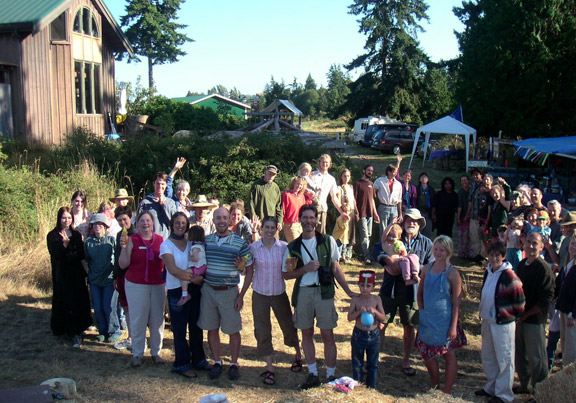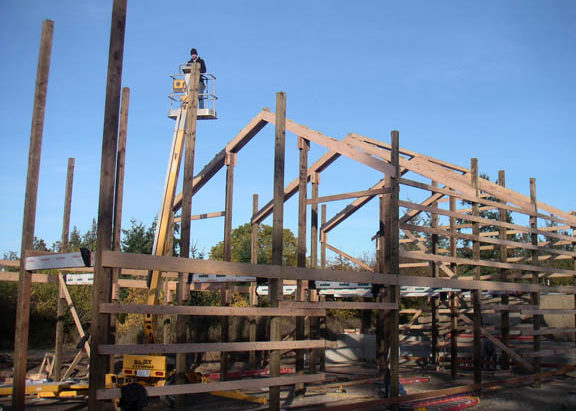The idea of an ecovillage emerged over Christmas dinner at Rosewind Co-housing (our next door neighbors) in 2003, driven by a vision of living more lightly on the earth. Kees and Helen Kolff already owned the 7 acres that is now the Port Townsend EcoVillage (PTEV) and had some experience as members of RoseWind. However, they had no idea of what it would take to build an intentional community from scratch – especially a community that tried to minimize its ecological footprint, provide for economic diversity, adhere to compassionate communication, stick with consensus, use permaculture principles, and grow much of its own food.
 The first PTEV Advisory Group was formed in February of 2004 with over a dozen members, and a Vision Statement was created that has served us well ever since. From the vision we developed a Mandala, which is a model of clarifying how our core values guide our principles and attitudes, from which flow our actions and structures on the land. This method has kept us on track as we explore options for realizing our vision. Realizing that Utopia really means “no place,” we continue to struggle between what is ideal and what is practical as we evolve to become more sustainable.
The first PTEV Advisory Group was formed in February of 2004 with over a dozen members, and a Vision Statement was created that has served us well ever since. From the vision we developed a Mandala, which is a model of clarifying how our core values guide our principles and attitudes, from which flow our actions and structures on the land. This method has kept us on track as we explore options for realizing our vision. Realizing that Utopia really means “no place,” we continue to struggle between what is ideal and what is practical as we evolve to become more sustainable.
After considering various legal structures over the years, in 2010 we finally settled on organizing ourselves as a Homeowners’ Association, primarily to make mortgages and other financial benefits available to our members. We sold 7 of the 12 lots available for building new residences and continued to seek new members.
Our commitment to the 3 main Permaculture principles of caring for the earth, caring for each other, and sharing the surplus was launched by our first 10-day Permaculture certification course with Doug Bullock and Toby Hemenway in 2004. A natural building workshop in 2005 and another Permaculture course in 2006 resulted in several useful and creative structures: a cob bench and oven, a light straw wall play structure for kids, and a pump house with natural foundation and living roof, water catchment systems on the shop, and a passive solar food dryer from a roadside refrigerator.
 Our first family camp occurred in the summer of 2006, with over 100 people participating in activities like extracting honey, face- painting, pony rides, music, talent shows and campfires. That year we also organized 20 participants to plant, weed, harvest and eat from the garden. Each year since then has seen an expansion of our vegetable beds and orchards.
Our first family camp occurred in the summer of 2006, with over 100 people participating in activities like extracting honey, face- painting, pony rides, music, talent shows and campfires. That year we also organized 20 participants to plant, weed, harvest and eat from the garden. Each year since then has seen an expansion of our vegetable beds and orchards.
 In 2007, our first small ecological home was built and in the last few years, another three houses were added and three more are on the way. In 2008, we built the shell of a 3600 square foot shop/arts center that we are completing over time. The SAC, as we call it, will include a large shop on the first floor (already in use) and combination of arts and craft space, personal storage and kids’ play space on the upper floor. In 2009, we added an attached greenhouse to the SAC and for several months hosted a group of homeschool students who made great use of the land and a warm place to gather.
In 2007, our first small ecological home was built and in the last few years, another three houses were added and three more are on the way. In 2008, we built the shell of a 3600 square foot shop/arts center that we are completing over time. The SAC, as we call it, will include a large shop on the first floor (already in use) and combination of arts and craft space, personal storage and kids’ play space on the upper floor. In 2009, we added an attached greenhouse to the SAC and for several months hosted a group of homeschool students who made great use of the land and a warm place to gather.
In addition to all the building of homes, we have also paid particular attention to building the social fabric of our community. We have participated in diversity and personal growth workshops and worked through conflicts using NVC (Nonviolent Communication). We have celebrated the seasons and our members’ life passages—births, deaths, weddings.
The continuing global ecological, economic and social crises make more urgent than ever the need for people to live together more peacefully, justly and gently on the Earth. That is the vision we wish to realize for ourselves and for future generations.
